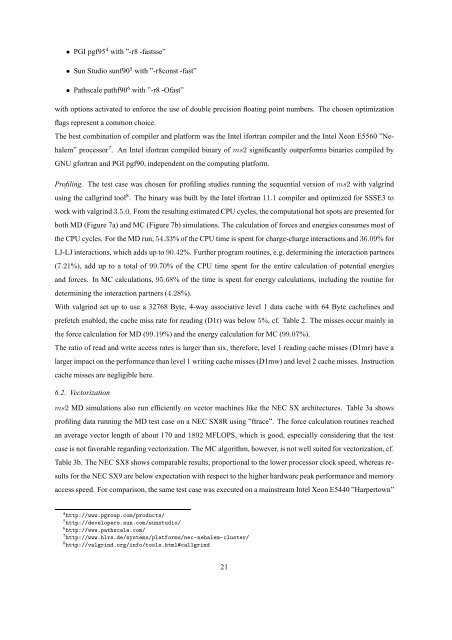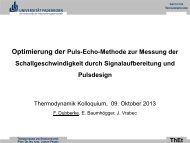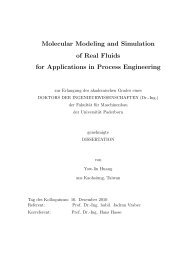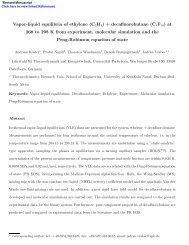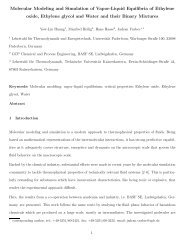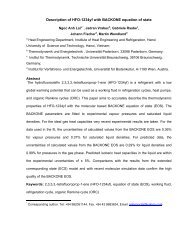ms2: A Molecular Simulation Tool for Thermodynamic Properties
ms2: A Molecular Simulation Tool for Thermodynamic Properties
ms2: A Molecular Simulation Tool for Thermodynamic Properties
You also want an ePaper? Increase the reach of your titles
YUMPU automatically turns print PDFs into web optimized ePapers that Google loves.
• PGI pgf95 4 with ”-r8 -fastsse”<br />
• Sun Studio sunf90 5 with ”-r8const -fast”<br />
• Pathscale pathf90 6 with ”-r8 -Ofast”<br />
with options activated to en<strong>for</strong>ce the use of double precision floating point numbers. The chosen optimization<br />
flags represent a common choice.<br />
The best combination of compiler and plat<strong>for</strong>m was the Intel i<strong>for</strong>tran compiler and the Intel Xeon E5560 ”Ne-<br />
halem” processor 7 . An Intel i<strong>for</strong>tran compiled binary of <strong>ms2</strong> significantly outper<strong>for</strong>ms binaries compiled by<br />
GNU g<strong>for</strong>tran and PGI pgf90, independent on the computing plat<strong>for</strong>m.<br />
Profiling. The test case was chosen <strong>for</strong> profiling studies running the sequential version of <strong>ms2</strong> with valgrind<br />
using the callgrind tool 8 . The binary was built by the Intel i<strong>for</strong>tran 11.1 compiler and optimized <strong>for</strong> SSSE3 to<br />
work with valgrind3.5.0. From the resulting estimated CPU cycles, the computational hot spots are presented <strong>for</strong><br />
both MD (Figure 7a) and MC (Figure 7b) simulations. The calculation of <strong>for</strong>ces and energies consumes most of<br />
the CPU cycles. For the MD run,54.33% of the CPU time is spent <strong>for</strong> charge-charge interactions and36.09% <strong>for</strong><br />
LJ-LJ interactions, which adds up to90.42%. Further program routines, e.g. determining the interaction partners<br />
(7.21%), add up to a total of 99.70% of the CPU time spent <strong>for</strong> the entire calculation of potential energies<br />
and <strong>for</strong>ces. In MC calculations, 95.68% of the time is spent <strong>for</strong> energy calculations, including the routine <strong>for</strong><br />
determining the interaction partners (4.28%).<br />
With valgrind set up to use a 32768 Byte, 4-way associative level 1 data cache with 64 Byte cachelines and<br />
prefetch enabled, the cache miss rate <strong>for</strong> reading (D1r) was below 5%, cf. Table 2. The misses occur mainly in<br />
the <strong>for</strong>ce calculation <strong>for</strong> MD (99.19%) and the energy calculation <strong>for</strong> MC (99.07%).<br />
The ratio of read and write access rates is larger than six, there<strong>for</strong>e, level 1 reading cache misses (D1mr) have a<br />
larger impact on the per<strong>for</strong>mance than level 1 writing cache misses (D1mw) and level 2 cache misses. Instruction<br />
cache misses are negligible here.<br />
6.2. Vectorization<br />
<strong>ms2</strong> MD simulations also run efficiently on vector machines like the NEC SX architectures. Table 3a shows<br />
profiling data running the MD test case on a NEC SX8R using ”ftrace”. The <strong>for</strong>ce calculation routines reached<br />
an average vector length of about 170 and 1892 MFLOPS, which is good, especially considering that the test<br />
case is not favorable regarding vectorization. The MC algorithm, however, is not well suited <strong>for</strong> vectorization, cf.<br />
Table 3b. The NEC SX8 shows comparable results, proportional to the lower processor clock speed, whereas re-<br />
sults <strong>for</strong> the NEC SX9 are below expectation with respect to the higher hardware peak per<strong>for</strong>mance and memory<br />
access speed. For comparison, the same test case was executed on a mainstream Intel Xeon E5440 ”Harpertown”<br />
4 http://www.pgroup.com/products/<br />
5 http://developers.sun.com/sunstudio/<br />
6 http://www.pathscale.com/<br />
7 http://www.hlrs.de/systems/plat<strong>for</strong>ms/nec-nehalem-cluster/<br />
8 http://valgrind.org/info/tools.html#callgrind<br />
21


